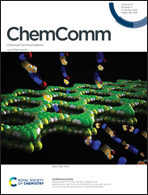Cu2+-binding to S100B triggers polymerization of disulfide cross-linked tetramers with enhanced chaperone activity against amyloid-β aggregation†
Abstract
S100B is an extracellular protein implicated in Alzheimer's Disease and a suppressor of amyloid-β aggregation. Herein we report a mechanism tying Cu2+ binding to a change in assembly state yielding disulfide cross-linked oligomers with higher anti-aggregation activity. This chemical control of chaperone function illustrates a regulatory process relevant under metal and proteostasis dysfunction as in neurodegeneration.



 Please wait while we load your content...
Please wait while we load your content...